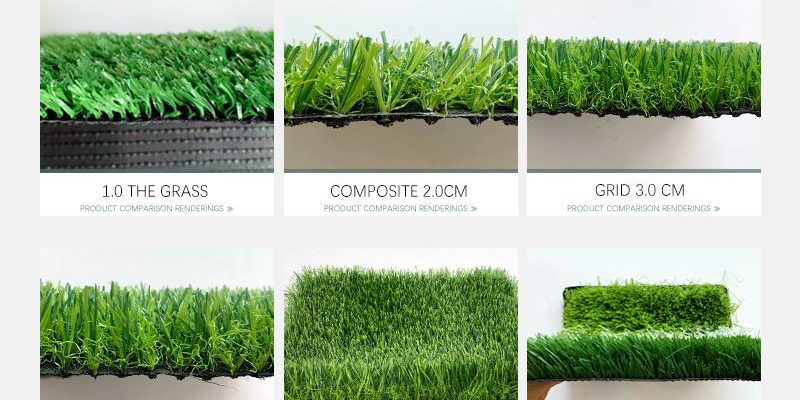Was ist Kunstrasen hergestellt aus? Auf welchen Oberflächen kann Kunstrasen verlegt werden?? Wird der Kunstrasen bei direkter Sonneneinstrahlung heiß??
Kunstrasen, auch bekannt als Kunstrasen, ist eine beliebte Alternative zu Naturrasen. Es besteht aus verschiedenen Materialien und kann auf verschiedenen Oberflächen installiert werden. Lassen Sie uns diese Themen genauer untersuchen:
Was ist Kunstrasen hergestellt aus?
Kunstrasen wird typischerweise aus einer Kombination von hergestellt synthetische Materialien, einschließlich Polyethylen, Polypropylen, und Nylon. Diese Materialien sind so konzipiert, dass sie das Aussehen und die Haptik von Naturrasen nachahmen und gleichzeitig Haltbarkeit und Langlebigkeit bieten.
Die Kunstrasenhalme bestehen aus verschiedenen Materialien, einschließlich Polyethylen, das häufig wegen seiner Weichheit und Haltbarkeit verwendet wird. Nylon ist ein weiteres beliebtes Material, das aufgrund seiner Festigkeit und Widerstandsfähigkeit verwendet wird. Die Unterlage des Kunstrasens besteht typischerweise aus Latex oder Polyurethan, was für Stabilität und Halt sorgt.
Einige Hersteller integrieren auch zusätzliche Materialien in ihre Kunstrasenprodukte um ihre Leistung zu steigern. Zum Beispiel, Einige Kunstrasenprodukte enthalten antimikrobielle Wirkstoffe, um das Wachstum von Bakterien und Pilzen zu verhindern, während andere es getan haben UV-Inhibitoren um das Ausbleichen durch Sonneneinstrahlung zu reduzieren.
Auf welchen Oberflächen kann Kunstrasen verlegt werden??
Kunstrasen kann auf verschiedenen Oberflächen verlegt werden, einschließlich Boden, Beton, Asphalt, und Terrassendielen. Jedoch, Die Installationsprozess kann je nach Untergrund variieren.
Bei der Installation von Kunstrasen auf Erde, Der erste Schritt besteht darin, das Gebiet bis zu einer Tiefe von ca 3-4 Zoll. Dies geschieht, um vorhandenen Rasen zu entfernen und eine ebene Fläche für die Installation des Kunstrasens zu schaffen. Eine Schicht aus Brudelstein oder es wird Kies hinzugefügt, um für die Entwässerung zu sorgen. Endlich, Der Kunstrasen wird darauf gelegt und befestigt.
Bei der Installation von Kunstrasen auf Beton oder Asphalt, Der Prozess ist etwas anders. Die Oberfläche muss gereinigt und geebnet werden, Eventuelle Risse und Unebenheiten müssen verspachtelt werden. Anschließend wird eine Schicht Kleber auf die Oberfläche aufgetragen, Darauf wird der Kunstrasen gelegt und befestigt.
Bei der Installation von Kunstrasen auf Terrassendielen, Die Oberfläche muss gereinigt und vorbereitet werden, um sicherzustellen, dass sie flach und eben ist. The artificial grass is then laid on top and secured in place using adhesive or clips.
Wird der Kunstrasen bei direkter Sonneneinstrahlung heiß??
Kunstrasen kann bei direkter Sonneneinstrahlung heiß werden, insbesondere in den Sommermonaten. Dies liegt daran, dass die synthetischen Materialien, aus denen das Gras besteht, die Wärme der Sonne absorbieren.
Jedoch, Hersteller haben Techniken entwickelt, um die Wärmeaufnahme von Kunstrasen zu reduzieren. Eine Technik besteht darin, zu integrieren hellere Farben in die Grashalme, die mehr Sonnenlicht reflektieren und weniger Wärme absorbieren. Eine andere Technik besteht darin, Füllmaterialien hinzuzufügen, wie zum Beispiel Quarzsand oder Gummi, zu den Grashalmen. Diese Materialien tragen dazu bei, die Wärme abzuleiten und den Kunstrasen kühler zu halten.
Es ist wichtig zu beachten, dass die Temperatur von Kunstrasen je nach verschiedenen Faktoren variieren kann, einschließlich der Farbe des Grases, die Menge der verwendeten Füllung, und die Intensität des Sonnenlichts. Wenn Sie sich Sorgen über die Hitze Ihres Kunstrasens machen, Es empfiehlt sich, mit dem Hersteller zu sprechen, um das beste Produkt für Ihre Bedürfnisse zu ermitteln. Zusätzlich, Es wird empfohlen, während der heißesten Zeit des Tages nicht auf dem Kunstrasen zu laufen, um das Risiko von Verbrennungen oder Unwohlsein zu verringern.







